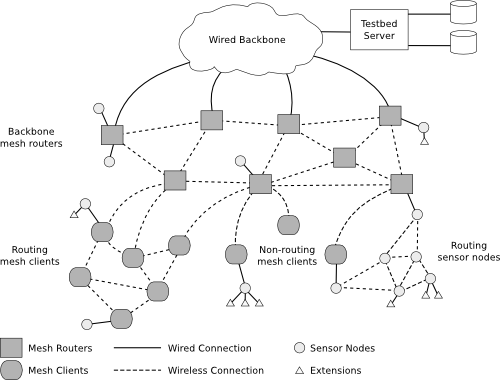MIOT-Lab
Miot-Lab
The Magdeburg Internet of Things Lab (MIoT-Lab) at the Otto-von-Guericke University of Magdeburg (OVGU) is a non-commercial research testbed.It consists of nodes located in offices, seminar rooms, and laboratories accross the campus. This distribution of the nodes provides the researcher with a realistic environment with interference, obstacles, and changing conditions. In its final stage the MIoT-Lab will consist of approximately 200 nodes.
The MIoT-Lab is a scientific tool to aid research in the fields of communication and networked systems. It provides different scales of hardware setup and various wireless network technologies. The main application domains are the Internet of Things (IoT) and Digital Twins for different entities.
The MIoT-Lab particularly aids the scientist first in large-sclae real-world experiments and second in the comparison of simulation studies and real world studies. As publications show, there is still a severe difference between the results of simulation studies and real world experiments as it is difficult to factor in all impacting environmental parameters. Since an individual hardware setup for a specific research problem is quite expensive and the requirements for experiment replications are hard to met, the MIoT-Lab depicts a compromise by reducing the cost, complexity, and at the same time providing a faithful environment.
The MIoT-Lab supports the researcher via:
-
Scheduled run of experiments via the testbed management system (DES-TBMS)
-
Experiment description and definition via a domain specific language (DES-Cript)
-
Replication of experiments via an experiment life cycle.
Hardware
The MIoT-Lab follows a hybrid approach: An MIoT-Node consists of an x86 node connected via IEEE 802.3 (Ethernet) to the MIoT-Lab management system and an embedded node. The x86 nodemanages the software, controls experiments, and collects data. In addition the x86 node can perform experiments concerning IEEE 802.11 (WiFi). The embedded node is programmed by the x86 node and is equipped with power monitoring capabilities as well as multiple sensors, while also providing several means of connectivity in the ISM frequencies. The hardware elements are placed on three tiers of a custom acrylic housing. In order to minimize production cost and time for developmend almost all the components are commercially available.
Research Focus
 The research focus of the MIOT-Testbed is primarily on comparisons of simulations and real world studies. As recent publications showed, there is still a severe difference in the results obtained from simulation environments compared to real world experiments. Most network simulators abstract from the wireless medium and do not consider an operating system being used on real hardware. The properties of the operating system, especially scheduling strategies and multi-threading, can affect the behavior of the algorithms and therefore influence the outcome. Additionally, the architecture of the network protocol stacks has to be considered. When implementing algorithms real world systems, the Application Programming Interface (API) of the underlying operating system kernel has to be used. Very often, simple modifications cannot be implemented easily. In simulation environments however, there are little restrictions. With the help of the MIOT-Testbed we are evaluating routing algorithms in order to get information that can be used in real world scenarios and improve everyday life applications, for example providing Internet access in rural areas that lack a wired infrastructure.
The research focus of the MIOT-Testbed is primarily on comparisons of simulations and real world studies. As recent publications showed, there is still a severe difference in the results obtained from simulation environments compared to real world experiments. Most network simulators abstract from the wireless medium and do not consider an operating system being used on real hardware. The properties of the operating system, especially scheduling strategies and multi-threading, can affect the behavior of the algorithms and therefore influence the outcome. Additionally, the architecture of the network protocol stacks has to be considered. When implementing algorithms real world systems, the Application Programming Interface (API) of the underlying operating system kernel has to be used. Very often, simple modifications cannot be implemented easily. In simulation environments however, there are little restrictions. With the help of the MIOT-Testbed we are evaluating routing algorithms in order to get information that can be used in real world scenarios and improve everyday life applications, for example providing Internet access in rural areas that lack a wired infrastructure.
Next to these research activities is the combination of sensor nodes and mesh routers based on IEEE 802.11 yielding further opportunities. The two components form two coexistent testbeds and take advantage of the features arising from the hybrid approach. The sensor nodes provide an additional network interface to the mesh routers and therefore offer channels in the ISM frequency band that are orthogonal to IEEE 802.11. Additionally, the MSB-A2 boards can be equipped with sensors and actors that can also be utilized by the mesh routers. Similarly, the sensor nodes exploit the hybrid infrastructure to establish virtual connections with far away nodes using the Ethernet backbone. The wired connection also provides an additional reliable packet loss detection mechanism. The constraint of limited power resources can be simulated by measuring the power consumption using a coulomb counter and shutting off nodes if a certain threshold is exceeded.
The MIOT-Testbed is also used in daily teaching activities giving students the opportunity to apply their knowledge attained in classes. Around 5 students are working on their theses at all times using the MIOT-Testbed.
